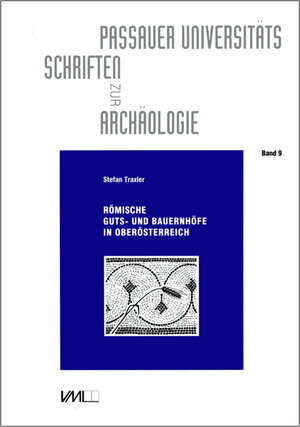
×
![Buchcover ISBN 9783896461766]()
Das Buch beginnt mit Teil I zu Forschungsstand und Terminologie sowie Teil II zu den nachgewiesenen Gutshöfen und Bauernhöfen, die auf Forschungsgeschichte, Topographie, Anlage, Bauweise, Raumaufteilung, Ausstattung, Funktion, Chronologie und Gutsherren untersucht werden. Dem folgen als Teil III der Katalog sowie als Teil IV Resümees zu diversen Bautypen [Gehöftformen, Hauptgebäude, Bäder] und Chronologie [Siedlungsbeginn in zwei Wellen seit dem späten 1. bzw. seit Anfang des 2. Jhs. n. Chr., Blüte im späteren 3. Jh., Ende teils im späten 2. / frühen 3. Jh., teils im späten 4. oder gar frühen 5. Jh.]. Teil V enthält Ausblicke in angrenzende Gebiete in Form von Beiträgen zu Gutshöfen und Bauernhöfen im südöstlichen Bayern, in Salzburg und im westlichen Niederösterreich [S. Jäger-Wersonig, R. Risy, Ch. Schwanzar und B. Tober]. Teil VI dient der Interpretation der Verbreitungskarte, wobei fünf Villengruppen beschrieben [Braunau, Salzkammergutseen, Tergolape-Laciacis, Ovilavis und Lauriacum] und vier Sonderfälle ausgegliedert werden. Das Werk schließt mit Teil VII, einem Anhang mit Literatur, einem umfangreichen Ortsindex und einer Verbreitungskarte.
The volume starts with part I on the present state of research and the terminology and part II on the attested villae and farms, which are investigated with regard to history of research, topography, arrangement, construction method, room organization, equipment, function, chronology, and owners. This is followed by part III, the catalogue, and part IV with résumés on building types [farm types, main buildings, baths] and chronology [beginning in two stages from the late 1st or early 2nd century A. D. onwards, heyday in the later 3rd century, end partly in the late 2nd / early 3rd century, partly in the late 4th or even early 5th century]. Part V contains outlooks into neighbouring areas in the shape of contributions on villae and farms in south-east Bavaria, in Salzburg, and in the west of Lower Austria [S. Jäger-Wersonig, R. Risy, Ch. Schwanzar, and B. Tober]. Part VI contains the interpretation of the distribution map which leads to the description of five groups of villae [Braunau, lakes of the Salzkammergut area, Tergolape-Laciacis, Ovilavis, and Lauriacum] and the exclusion of four exceptions. The work concludes with part VII, an appendix with literature, a substantial site index, and a distribution map.
The volume starts with part I on the present state of research and the terminology and part II on the attested villae and farms, which are investigated with regard to history of research, topography, arrangement, construction method, room organization, equipment, function, chronology, and owners. This is followed by part III, the catalogue, and part IV with résumés on building types [farm types, main buildings, baths] and chronology [beginning in two stages from the late 1st or early 2nd century A. D. onwards, heyday in the later 3rd century, end partly in the late 2nd / early 3rd century, partly in the late 4th or even early 5th century]. Part V contains outlooks into neighbouring areas in the shape of contributions on villae and farms in south-east Bavaria, in Salzburg, and in the west of Lower Austria [S. Jäger-Wersonig, R. Risy, Ch. Schwanzar, and B. Tober]. Part VI contains the interpretation of the distribution map which leads to the description of five groups of villae [Braunau, lakes of the Salzkammergut area, Tergolape-Laciacis, Ovilavis, and Lauriacum] and the exclusion of four exceptions. The work concludes with part VII, an appendix with literature, a substantial site index, and a distribution map.


